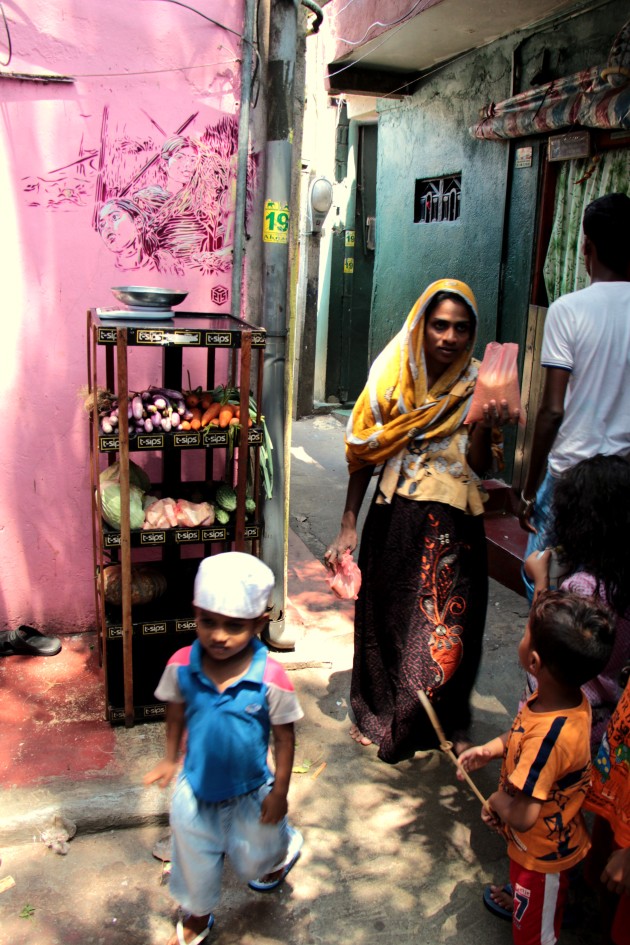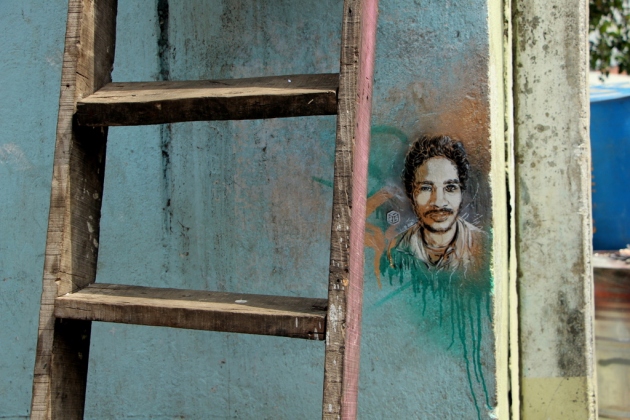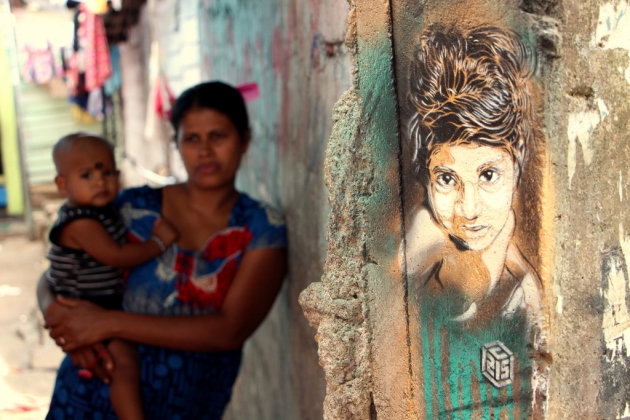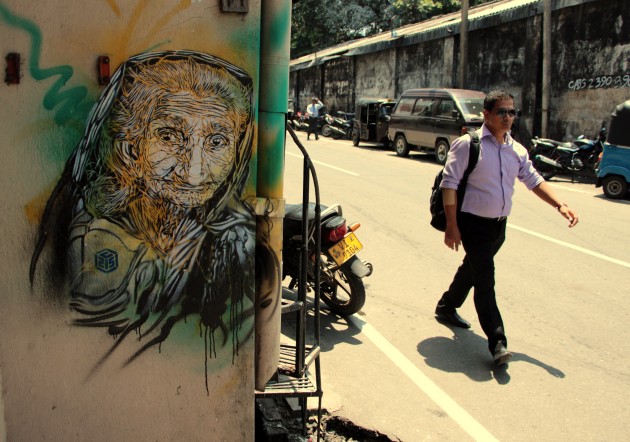A man (Gihan, he tells me his name later) catches sight of me surveying a stencil of a smiling child sandwiched between a photocopy shop and a dilapidated building on Dawson Street, and signals from across the road: “There’s more over here”. Cheerfully appointing himself as my guide and with a number of wide eyed, bashful children in tow, we weave our way through a path punctuated with bird droppings, ceramic bathroom fittings, criss-crossing clothes lines, concrete debris, drains and enter the unlikeliest of art spaces.
*
Lately, I’ve been juggling multiple lives. I secretly revel in the bustle that working divergent jobs bring. One line of work brings in a hint of order and solidity. The other brings in an element of uncertainty and creativity — never know if I’ll land up at a fish market, a five star hotel or as in this instance, alleys in Slave Island.
Occasionally during my moonlighting work, there’s a story which lingers long after I’ve transcribed the interview, wrestled with the deadline and then laid the article to rest. An interview with French artist C215, who was in Colombo recently, was one of those which stubbornly persisted. I’d mentally dog-eared his work when I had come across one of his graffiti stencils in Delhi years ago and was pleasantly surprised when I saw his cube shaped signature in Colombo. After our conversation, I found myself returning twice to Slave Island on a graffiti hunt, retracing the artist’s path, in search of pockets of colourful graffiti tucked away in unexpected nooks and crannies.
If you’re a fan of street art, C215’s work abroad is worth browsing. Favourites include the Caravaggio series, the stained glass series, this one of a couple (she has such an interesting face) and a recent tribute to Robin Williams. Christian Guémy’s technique is a head-on collision between the scrupulous detail of the classical and the unaffected spontaneity of street art (“You plan nothing and begin something – things happen with interaction”). There’s a gentle hijacking of standard, flat stencil art with layers of colours and minute details giving his work an unexpected depth.

Street Cat – Definitely a favourite from the stencils in Colombo. So easy to miss this when you’re walking past.
His choice of locations in Colombo were especially intriguing. I liked that he deliberately stepped out of Colombo’s rarefied art bubble and transformed non-spaces into visual poetry — all with polite permission from the residents and owners, mind. “I’ve always been interested in exploring the world. This kind of painting is a kind of exploration,” he shrugged. During our conversation, Christian pointed out that he liked people to follow his path, to wander down a street where they have nothing to do or no reason to go. “I think that the little street I have been painting in are not the streets you put on the tourist guides,” he remarked wryly, “but maybe rich people are making the right Colombo”.
Christian’s stencils painted in Sri Lanka varied between those from his existing library of stencils from his work around the world to site-specific ones of the people of Slave Island themselves. Creating site-specific stencils is laboriously meticulous work and is a back and forth looping between the virtual and the real. It entails multiple visits to the same location, photographing people, printing the pictures out, carving out the stencils by hand from the printed portraits and then finally returning to paint. Once the painting is complete it is again documented and distributed online – almost a tango of sorts between multiple layers of the virtual and the real.
*
Street art has a short lifespan. While the rest of the art world battles time and decay in the fight for preservation, street art is resolutely temporal with an oddly poignant acceptance of the inevitability of aging, decay and deterioration. “Nothing is permanent, everything is ephemeral. And this is something that I believe deeply […] In some way, creating art outside in a public space is also a kind of comment or a meditation about giving up with yourself, with your ego, with what you are — because it is something you leave behind you — you know you have to abandon it every day. And every day when you pass by, you have to abandon it [the art] for a new one,” voiced Christian, referring to the natural decay wrought on street art.
“You cannot look for being permanent by yourself as a human being — it’s the same with art. When I paint, I know it has a birth and it has a death. And that’s interesting because it (I speak for myself) helps me to accept that I am alive and I will die”.
*
Public art can heavily impact a city’s visual culture and there’s a lot of potential for street art in Colombo – hence my enthusiasm for the manner in which artists like Christian have employed the medium.
Martin Irvine sums it up eloquently in the Handbook of Visual Culture: “Whether the street works seem utopian or anarchic, aggressive or sympathetic, stunningly well-executed or juvenile, original or derivative, most street artists seriously working in the genre begin with a deep identification and empathy with the city: they are compelled to state something in and with the city, whether as forms of protest, critique, irony, humor, beauty, subversion, clever prank or all of the above. The pieces can be ephemeral, gratuitous acts of beauty or forms of counter-iconography, inhabiting spaces of abandonment and decay, or signal jams in a zone of hyper-commercial messaging. A well-placed street piece will reveal the meaning of its material context, making the invisible visible again, a city re-imaged and re-imagined”.
For the most part, graffiti in Colombo have been school boy scrawls (RC ROX 2 DA MAXX) of neither literary nor artistic merit and is understandably linked with vandalism. In terms of street art, the only public murals — as far as I know — are ones on school walls (which are tediously didactic in nature), a rather gruesome mural on Baseline Road and a few works here and there. I remember Artists Collectives like CoCA having plans for public art projects and it would be great to see more around Colombo.
One work of street art which is almost indelibly imprinted on my mind is this simple black and white line drawing which was done in 2006 in Kollupitiya during the war- I wish I knew who painted it. Days after an attack was carried out in Colombo, it popped up on the shrapnel pocked wall (remnants of the attack), only to be speedily taken down afterwards.
*
Ps: Shout-out to T for the early morning company on the second leg of the photo-jaunt.
Update: Hat tip to Janith for linking to more street art in Colombo.















Wonderfully written, A. You really captured the essence of the art. Maybe the art will give these places enough value to be deemed worthy of preservation, and not torn down to be replaced with some clinical highrise. Thanks for taking me with you. xo
LikeLike
Reblogged this on Chuls Bits & Pics and commented:
A side of Colombo I didn’t know — fascinating a must read!
LikeLike
Delightful — both text and photos
LikeLike
Very similar stencil street art has been created by c215 in delhi too, that cow graffiti and that girl one is there in delhi… see here http://netdost.com/profiles/blogs/graffiti-stencil-street-art-by-c215-on-the-streets-of-new-delhi
LikeLike
Fantastic Chuli. Thanks for this walk through this living gallery. Here is a challenge for designers of highrises!
LikeLike
Lovely writeup. I think Mathawaada did some stencil grafitti at one point too, but would be lovely to see good street art here. It’s a bit of a surprise with all the street-linked artistic traditions in this country that street art hasn’t become a thing.
LikeLike
Also, *whoa* at that fb share count. :O
LikeLike